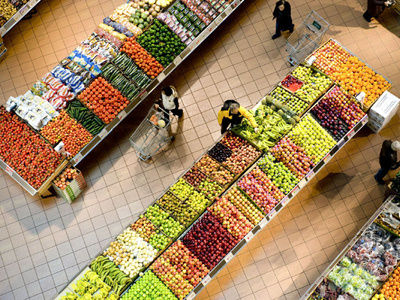
With several forecasts predicting food prices increasing anywhere from 1.5 per cent to 3.5 per cent in 2013, consumers will have to rethink how they will spend their hard-earned discretionary income, writes University of Guelph professor Sylvain Charlebois. News services file photo
Last year, Canadian consumers enjoyed modest increases in food prices. In fact, not only did food prices barely increase, but prices of fruits and vegetables decreased by more than eight per cent.
Unfortunately, 2013 will be a different story. Several forecasts predict food prices will go up anywhere from 1.5 per cent to 3.5 per cent, likely exceeding our national inflation rate.
In other words, consumers will have to rethink how they will spend their hard-earned discretionary income. Indeed, meat and poultry lovers will be especially hard hit as prices for meats will likely increase by more than 4.5 per cent.
With this rise in food prices, spending in other sectors is bound to decrease - a family may need to pass on that exquisite trip to Cancun or that new oversized television set.
While Mother Nature is always partially to blame for food price hikes, the "new normal" in the agriculture business is fluctuating food prices influenced by knee-jerk, hedging-like schemes perpetuated by an array of stakeholders in the industry.
The consequences of last year's North American drought had a relatively strong impact on food production and, in turn, will affect food prices in 2013. The extremity of this drought, the biggest of its kind in recent history, saw commodity prices increasing at a rate well above normal expectations. This was especially the case for corn and soybean crops in the U.S. Midwest, the area hit hardest by the drought.
Anticipating input costs to rise, many cattle producers liquated their herds to hedge against higher feed prices. With less supply on the market, by the time we reach barbecue season, Canadians will likely pay more for their favourite steak.
With grains, the situation is not optimistic either. Primarily due to the lack of buffer inventory in many countries to mitigate unpredictable climate patterns, the coming year will almost certainly see climate change have a bigger effect on food prices. Without extra grain inventory, droughts, floods, or other weather shocks will make markets more volatile and may, in turn, have a negative effect on the wallets of Canadians.
With that said, Canadians will get some welcome help from an increasingly competitive food distribution landscape. Major players in food retailing have been adjusting to Walmart's aggressive strategy in the Canadian market. The American-based giant has opened many new Supercentres in recent months and most large Canadian retailers, particularly Loblaws, have felt the pain. The imminent arrival of Target into the Canadian market in 2013 will create the perfect storm of competition for food retailers who are looking to retain their market share, and keeping food prices lower is a quick and dirty way to fend off competition.
In particular, Metro and Sobeys will experience a very harsh assault in Eastern Canada, courtesy of these two American retail giants. The result may be more consolidation in the food retailing industry, and it wouldn't be surprising if Canada loses one major food retailer over the next year or two. But at least in the near term, food prices at the local grocery store will be lower for Canadian shoppers.
The strong Canadian dollar will also help Canadian consumers looking for good deals in grocery stores. Canada is a large importer of foods from the United States and, with our American food imports exceeding $20 billion yearly, every cent gained by the loonie against the greenback has a significant impact on our buying power. When we factor in the state of the American economy and the relative stability of our own economy, the value of the Canadian dollar against the American dollar can only go up.
It is worth noting that energy won't be much of a factor moving forward, unlike in previous years. As the American government hones its efforts on energy sovereignty, the cost of food processing and distribution will remain relatively stable for a while.
Despite these positive signs, we could see a record number of people using food banks in 2013. As explained before, meat and poultry will cost more for the average family and, as a result, consumers will look for alternatives by considering more affordable sources of food.
However, there is something that consumers can do at home right now to help extend their food budgets: become better food waste managers. Even though we expect more consumers to visit food banks, we may see even more wasted food than ever next year. Indeed, studies have shown that Canadian households waste about 38 per cent of their food purchased in store and restaurants.
While it is almost certain that shopping habits will change as a result of food price increases, there is hope that there will be greater awareness of wasted food in Canadians homes and that these households will be more proactive about their food waste habits.
By adopting better shopping practices and using leftovers in creative ways, consumers could save more than 10 per cent in food costs, which is more than enough to offset anticipated food price increases over the next two to three years.
Becoming a better domestic food waste manager might be worth putting at the top of your list at this time of New Year's resolutions.
Sylvain Charlebois is associate dean of the college of management and economics at the University of Guelph. (Troy Media/troymedia.com)



Reader Comments
to our Newsletter